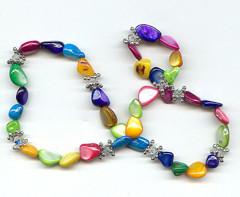Elements of Design – Which pattern formation should you choose?
Jewellery design work is very subjective, tastes vary considerably. And as the decades pass fashion plays and increasing roll in jewellery design. But whether classic or contemporary, 80’s big and bold or 30’s angular dimension, one thing you will have to decide upon in some kind of pattern formation.
A classic jewellery style will favour a symmetrical pattern. Symmetry is symbolic of a balanced life and many people will still gravitate towards a classic symmetrical style when selecting jewellery. A symmetrical pattern is considered safe. And will be favoured by a more conservative target audience.
[Hidepost=2]
Usually a symmetrical pattern will have both sides the same or in balance and typically in a necklace formation a larger bead or collection of beads will form the font centrepiece.
A repeating pattern is one where the bead placement forms a sequence or pattern. Necklaces of this type usually have no defined centre and it should be able to be worn without a thought being given to a focal point.
An asymmetrical pattern has at least two distinctive sides which do not reflect a line of symmetry. As fashions come and go asymmetrical patterns in jewellery favour certain decades. The 1980’s was famous for embracing asymmetrical patterns and as fashion jewellery at present has in part returned to that bolder period , it is worth considering making some bolder pieces of jewellery in an asymmetrical style.
Random patterns and designs have been very popular lately. Boho chic beaded charm bracelets are still as popular as every and there will always be a place for a more irregular style which cannot be quite defined.
Once you have considered your pattern or style for your jewellery piece then thought should be given to colour. In the west, silver toned jewellery outsells gold tones many times over and thought should be given to these economics. Silver toned jewellery is a “cool” colour and traditionally is matched with co-ordinating or contrasting colours. However, even though famed for its warm earthy tones, Amber is most often seen set in sterling silver proves that you do not have to be confined to traditional colour matching when designing your jewellery. You may find the use of a colour wheel particularly useful when designing to place colours together that you may not have even though about (to use a colourwheel, see our sister site click here). One of main problems of designing with colour is the temptation to stick to your own colour preferences. Everybody has favourite colours and it can sometimes be a little difficult to come out of your comfort zone and choose alternative colours.
Last but not least you need to give consideration to the weight and number of beads in your design. Very heavy or bulky necklaces may break with wear and tear and may even be uncomfortable to wear. And if you use a lot of expensive beads, you may find yourself with a piece of jewellery that is not economically viable to sell or even give away.
When planning your design, consider the effective use of spacer beads. Spacers can be a small bead that breaks up the main design making the main beads much more effective in their overall appearance. Using spacer beads, like seed beads is a great way to reduce costs and the weight of your design. So next time you are buying beads for your next jewellery design project, give equal thought to co-ordinating spacer beads which contribute to the overall finished look or your piece.
[/Hidepost]



 Click
Click